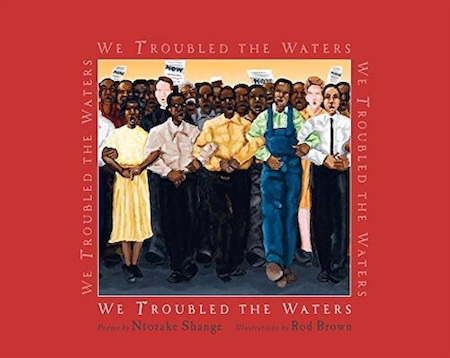We Troubled The Water
Jim Crow; Brown v. Board of Education; Bull Connor; KKK; Birmingham; the Lorraine Motel; Rosa; Martin; and Malcolm.
From slavery to the separation of “colored” and “white” and from horrifying oppression to inspiring courage, there are countless stories—both forgotten and immortalized—of everyday and extraordinary people who acted for justice during the civil rights movement that changed our nation.
Award-winning poet Ntozake Shange and illustrator Rod Brown give voice to all those who fought for their unalienable rights in a triumphant book about the power of the human spirit.
Praise & Reviews
“The events and people of the Civil Rights era, from the famous to the ordinary, are brought to life through stirring poetry and striking illustrations. In its opening pages, blue skies, warm sunlight, and lush greenery gives way to the unspeakable reality of Jim Crow in the form of a faceless body that tarnishes the tranquil scene. The simple day-to-day drudgery of scrubbing floors and washing laundry is eloquently described in “Cleaning Gal.” A palpable sense of foreboding and terror is apparent as the perils of trying to cast a ballot in the segregated South are detailed in “You Vote/You Die.” Unflinching words and stark artwork portray the horror of lynching in “Roadkill” and “Crying Trees.” Paintings depicting solemn-faced children, some in tattered clothes and others nicely dressed, give visual testimony to the strong desire to obtain an education in “Booker T. Washington School, 1941.” Inspirational verses express the philosophies of Martin Luther King, Jr., Malcolm X, and Rosa Parks, capturing the essence of these Civil Rights icons and why they were special to so many people. Historical events like the March on Washington are given a new voice as poetic language and panoramic views express emotion in a manner that standard factual treatment cannot. The triumph of the spirit and the determination and bravery of famous and everyday people are expressed on each page of this exceptional book. It should be in every collection.”
—School Library Journal (Starred Review)

